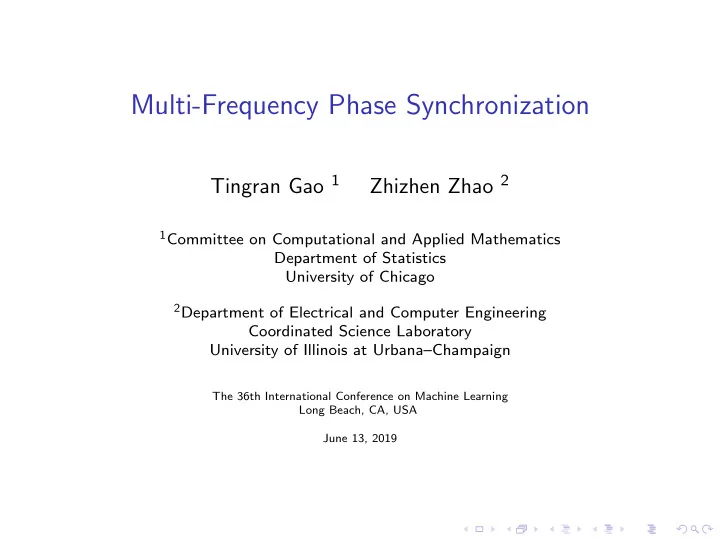

Multi-Frequency Phase Synchronization Tingran Gao 1 Zhizhen Zhao 2 1 Committee on Computational and Applied Mathematics Department of Statistics University of Chicago 2 Department of Electrical and Computer Engineering Coordinated Science Laboratory University of Illinois at Urbana–Champaign The 36th International Conference on Machine Learning Long Beach, CA, USA June 13, 2019
Phase Synchronization ◮ Problem: Recover rotation angles θ 1 , . . . , θ n ∈ [0 , 2 π ] from noisy measurements of their pairwise offsets θ ij = θ i − θ j + noise for some or all pairs of ( i , j ) ◮ Examples: Class averaging in cryo-EM image analysis, shape registration and community detection
Phase Synchronization � e ιθ 1 , . . . , e ιθ n � ⊤ ∈ C n ◮ Setup : Phase vector z = 1 , noisy pairwise measurements in n -by- n Hermitian matrix � e ι ( θ i − θ j ) = z i ¯ z j with prob. r ∈ [0 , 1] H ij = Uniform ( C 1 ) with prob. 1 − r and H ij = H ji . This is known as a random corruption model. ◮ Goal : recover the true phase vector z (up to a global multiplicative factor) ◮ Existing method : Rank-1 recovery (e.g. convex relaxations) � xx ∗ − H � 2 x ∗ Hx x := arg min ˆ ⇔ x := arg max ˆ F x ∈ C n x ∈ C n 1 1
Multi-Frequency Phase Synchronization ◮ Multi-Frequency Formulation: k max � ( x k ) ∗ H ( k ) x k max x ∈ C n 1 k =1 � � ⊤ ∈ C n where x k := 1 , and H ( k ) is the n -by- n x k 1 , . . . , x k n Hermitian matrix with H ( k ) := H k ij ij ◮ Intuition: Matching higher trigonometric moments ◮ Two-stage Algorithm: (i) Good initialization (ii) Local methods e.g. gradient descent or (generalized) power iteration
Initialization: Inspired by Harmonic Retrieval ◮ Fix k max ≥ 1, build H (2) , . . . , H ( k max ) out of H = H (1) ◮ For each k = 1 , . . . , k max , solve the subproblem u ( k ) := arg max v ∗ H ( k ) v v ∈ C n 1 using any convex relaxation, and set W ( k ) := u ( k ) � u ( k ) � ∗ ◮ For all 1 ≤ i , j ≤ n , find the “peak location” of the spectrogram � � � � k max � � � 1 W ( k ) ˆ � � e − ι k φ θ ij := arg max � � ij 2 � � φ ∈ [0 , 2 π ] k = − k max ◮ Entrywise normalize the top eigenvector ˜ x of Hermitian matrix H ij = e ι ˆ H , defined by � � θ ij , to get ˆ x ∈ C n 1
How well does it work? Evaluate correlation | Corr (ˆ x , z ) | Random Corruption Model, r = λ/ √ n Previous Art: Only ensures Our Method: | Corr (ˆ x , z ) | − → 1 1 | Corr (ˆ x , z ) | > for λ > 1 as k max ≫ 1 , even for λ < 1 ! √ n
Grounded Upon Solid Theory Theorem (Gao & Zhao 2019). With all (mild) assumptions satisfied, with high probability the multi-frequency phase synchronization algorithm produces an estimate ˆ x satisfying C ′ Corr (ˆ x , z ) ≥ 1 − k 2 max provided that 1 � � k max > max 5 , . √ � 2 π 1 − 4 C 2 σ log n / n − 2 In particular, Corr (ˆ x , z ) → 1 as k max → ∞ . • Tingran Gao and Zhizhen Zhao, “Multi-Frequency Phase Synchronization.” Proceedings of the 36th International Conference on Machine Learning, PMLR 97:2132–2141, 2019.
Thank You! Poster Today : 06:30–09:00PM � Pacific Ballroom #143 • Tingran Gao and Zhizhen Zhao, “Multi-Frequency Phase Synchronization.” Proceedings of the 36th International Conference on Machine Learning, PMLR 97:2132–2141, 2019. • Tingran Gao, Yifeng Fan, and Zhizhen Zhao. “Representation Theoretic Patterns in Multi-Frequency Class Averaging for Three-Dimensional Cryo-Electron Microscopy,” arxiv:1906.01082 .
Recommend
More recommend